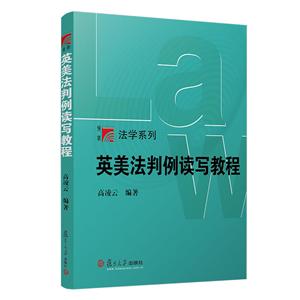PART I INTRODUCTION TO COMMON LAW SYSTEM Chapter 1 COMMON LAW 1.1 Law 1.2 Common Law 1.3 Law versus Equity 1.4 Statutory Law versus Case Law 1.5 Summary Review Questions Chapter 2 COMMON LAW COURT SYSTEM 2.1 The English Court System 2.1.1 Magistrates' Courts -- For Both Civil and Criminal Cases 2.1.2 County Courts -- For Civil Cases Only 2.1.3 Crown Court -- For Criminal Cases Only 2.1.4 High Court -- For Both Civil and Criminal Cases 2.1.5 Court of Appeal -- For Both Civil and Criminal Cases 2.1.6 Final Court of Appeals 2.1.7 European Court of Justice 2.2 The American Court System 2.2.1 The Federal Courts 2.2.2 State Courts Review Questions Chapter 3 SOURCES OF LAW 3.1 Sources of Law in England 3.1.1 The European Union Law 3.1.2 Statutory law 3.1.3 CaseLaw 3.2 Sources of Law in the United States 3.2.1 Constitutions 3.2.2 Statutes 3.2.3 Administrative Regulations 3.2.4 CaseLaw Review Ouestions Chapter 4 LEGAL PROCEEDINGS 4.1 Commencement of the Proceeding -- Pretrial 4.1.1 Filing with the Court: Complaint 4.1.2 Service of Process 4.1.3 The Response. Motion, Answer, and Reply 4.1.4 Discovery 4.2 Trial Date and Jury Selection 4.2.1 Trial Date Assignment 4.2.2 Jury Selection 4.2.3 Preliminary Instructions of Law 4.3 Trial 4.3.1 Opening Statements 4.3.2 Plaintiff's Case in Chief 4.3.3 Defendant's Case in Chief 4.3.4 Closing Arguments 4.3.5 Jury Instructions 4.3.6 Verdict 4.3.7 Motions 4.3.8 Judgment 4.4 Appeal 4.5 Summary Review QuestionsPART II CASE LAW Chapter 5 DOCTRINE OF STARE DECISIS 5.1 Rule of Precedent 5.2 Doctrine of Stare Decisis 5.3 The Function of Stare Decisis 5.4 Courts Affected by Stare Decisis 5.4.1 The Courts in England 5.4.2 The Courts in the United States 5.5 Components of a Judicial Decision 5.6 Types of Judicial Decisions 5.6.1 Majority Opinion 5.6.2 Dissenting Opinion 5.6.3 Concurring Opinion 5.7 Different Ways to Use Precedents 5.7.1 Following Prior Precedents 5.7.2 Distinguishing Prior Precedents 5.7.3 Overruling Prior Precedents Review Questions Chapter 6 COMMON LAW REASONING 6.1 Typical Types of Common Law Reasoning 6.1.1 Deductive and Inductive Reasoning 6.1.2 Analogy and Distinction 6.1.3 Arguments in Common Law Reasoning 6.2 Techniques and Arguments Used with Case Authorities 6.2.1 Favorable Authorities 6.2.2 Adverse Authorities 6.3 Illustration of the Common Law Reasoning 6.3.1 Fletcher v. Rylands -- The Establishment of the Rule 6.3.2 Rylands v. Fletcher Modification of the Rule 6.3.3 Rickards v. Lothian -- Exceptions to the Rule 6.3.4 Read v. Lyons -- Interpretation and Application of the Rule 6.3.5 Turner v. Big Lake Oil Co. The Impact of the Rule on the U.S. Courts 6.3.6 Foster v. Preston Mill Co. A Later Case Decided By a U. S. Court 6.3.7 Siegler v. Kuhlman -- Adoption of the Rylands Rule 6.3.8 Clay v. Missouri Highway & Transportation Commission -- New Development Review Questions Chapter 7 CASE REPORTING SYSTEMS 7.1 Law Reports in England 7.1.1 Law Reports 7.1.2 Format of a Case in the Law Reports 7.2 Case Reporters in the United States 7.2.1 Case Reporters 7.2.2 Case Digests 7.2.3 Format of a Case in the Case Reporters 7.3 Case Names and Citations 7.3.1 Case Names 7.3.2 Case Citations Review QuestionsPART III CASE ANALYSIS Chapter 8 CASE ANALYSIS 8.1 Basic Structure of a Judicial Opinion 8.1.1 Different Types of Opinions 8.1.2 Common Actions of a Court 8.1.3 Essential Elements of an Opinion 8.2 Procedural History 8.3 Statement of Facts 8.4 Issue 8.5 Holding 8.6 Reasons and Policies 8.7 Judgment 8.8 Summary 8.9 Case Brief Exercises 8.9.1 Exercise 1. Katko v. Briney 8.9.2 Exercise 2. Palsgraf v. Long Island Railroad Co.
8.9.3 Exercise 3. Barnes v. Treece 8.10 Summary Review QuestionsPART IV LEGAL DOCUMENT DRAFTING Chapter 9 Memoranda Drafting 9.1 Common Law Analyses 9.2 Principles of Drafting 9.3 Writing Techniques 9.4 Elements of a Memorandum 9.5 Heading 9.6 Questions Presented 9.7 Brief Answers 9.8 Statement of Facts 9.9 Discussion 9.10 Conclusion 9.11 Summary 9.12 Drafting Exercise Review QuestionsREFERENCES





















